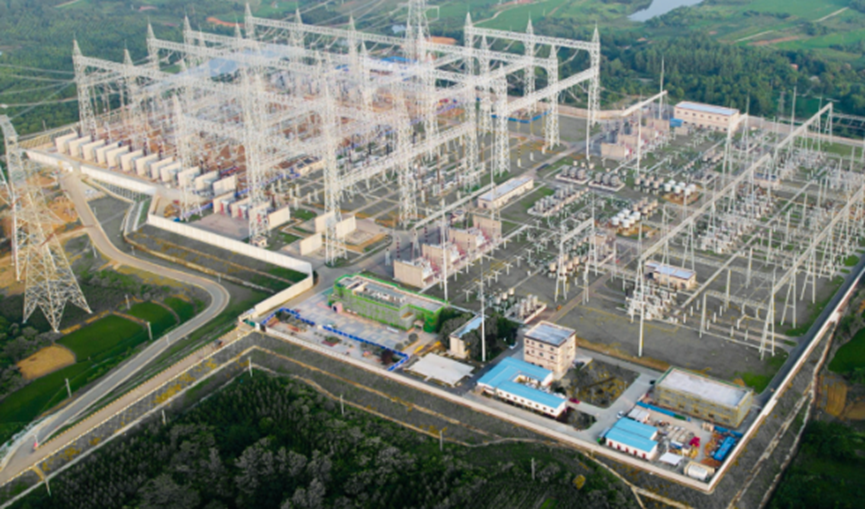From power plants to your home outlets, substations serve as essential "energy transfer stations." Without them, air conditioners wouldn't run, phones couldn't charge, and lights wouldn't illuminate. Why is that? Because electricity generated at power plants isn't ready for direct use! For instance, electricity from thermal or hydroelectric plants carries voltages as high as hundreds of thousands of volts or even more. If such high voltage were directly connected to homes, appliances would instantly burn out, and wiring could catch fire due to excessive current.
A substation, in simple terms, is a facility designed to transform the voltage levels of alternating current (AC). Within power systems, the electricity generated at power plants often requires multiple stages of voltage step-up and step-down processing to ensure safe and efficient delivery to end users. Substations serve as the core component enabling this process. Through equipment like transformers, they adjust voltage levels, making long-distance transmission feasible while also meeting the varying voltage requirements of different power consumption scenarios. Based on their location and function, substations can be categorized into types such as step-up substations, step-down substations, and interconnection substations. A typical substation primarily consists of the following sections: high-voltage incoming lines, transformer bays, low-voltage outgoing switchgear, control and protection systems, and auxiliary facilities.
Among these, auxiliary control equipment (referred to as "auxiliary control devices") within substations—such as ventilation and air conditioning systems, drainage pumps, lighting systems, firefighting facilities, security monitoring, and environmental monitoring equipment—have long faced industry pain points including fragmented management, data silos, and inefficient operations and maintenance. These issues have become the "weak link" hindering the advancement of substation intelligence. Based on deep insights into substation O&M requirements, Dingxin Smart Technology has developed the DX-BTS100-ZF Intelligent Monitoring System for Auxiliary Control Equipment in Smart Substations. Through innovative designs featuring centralized control, intelligent interconnection, and data-driven operations, this system resolves traditional auxiliary control O&M challenges, establishing a new "safe, efficient, and energy-saving" O&M ecosystem for smart substations.
Next, Dingxin Wisdom Technology Co., Ltd. would like to highlight theDX-BTS100-ZFIntelligent Monitoring System for Auxiliary Control Equipment in Smart Substations. The system enables real-time monitoring of substation operating conditions, including temperature, humidity, water ingress, smoke detection, wind speed, and arcing, with live video and data access.
Video surveillance offers features such as facial capture, infrared illumination, linked monitoring, automatic tracking, detail capture, and smart event detection. Intelligent control enables the built-in high-current relay module to achieve linked or remote control of circulation fans, water pumps, infrared lights, and lighting fixtures, as well as air conditioning control functions. Security prevention equipment primarily consists of electronic fences, infrared beams, vibration detectors, and dual-technology infrared detectors. The access control video intercom system utilizes integrated facial recognition units, introducing a new management model for entrances and exits. Combining facial recognition technology with modern security management measures, it significantly enhances real-time monitoring capabilities and access permission management for unmanned premises.
Features
1. Real-time Video Surveillance: Utilizing high-quality industrial cameras with dustproof and waterproof capabilities, it continuously captures clear images 24/7 to meet diverse area monitoring needs. Supports pan-tilt-zoom (PTZ) operation for comprehensive, multi-angle surveillance with no blind spots.
2. Voice Communication: Supports two-way voice communication, recording, broadcasting, and monitoring between municipal clients and front-end devices.
3. Video Storage and Playback: Front-end video and audio feeds are ingested into the hard disk recorder for storage, supporting uninterrupted recording with a retention period of no less than 90 days. The central platform enables retrieval, playback, or download of specified recordings.
4. Video Analysis: Capable of analyzing equipment, personnel behavior, environmental conditions, and video quality.
5. Remote Equipment Inspection: Supports visual inspection plans, allows screenshot annotation of issues, intelligently identifies equipment status, and generates inspection reports.
6. Infrared Online Temperature Monitoring: Utilizes infrared thermal imaging to patrol critical equipment, providing real-time temperature monitoring. Alarms trigger upon detecting anomalies, with historical data automatically saved.
7. Online Audio Monitoring: Real-time monitoring of equipment operational status with AI microphone-based decibel and frequency threshold analysis and alerts.
8. Production-Business Integration: Interface with communication servers to enable remote operation or, in case of equipment failure, trigger monitoring points to capture and upload images, achieving visual operational management.
9. Online Environmental Monitoring: Sensors collect environmental data, which is aggregated and forwarded to the control center via the environmental monitoring host. This generates curve reports and triggers alarms in case of anomalies.
10. On-site Intelligent Interconnection: Video surveillance integrates with auxiliary systems to provide video-based contingency plans. It also supports other response protocols, such as activating air conditioning when temperature/humidity exceeds thresholds and turning on lights upon infrared dual-detection alarms.
11. Remote Fire Alarm Data Transmission: Incorporate a user information transmission device to uniformly convert protocols from various fire alarm control panels and transmit data to the central monitoring station.
12. Access Control Facial Recognition: The integrated facial recognition terminal features a built-in facial database. When a registered individual is identified, the system automatically unlocks the electric door lock.
13. Video Intercom Access Control: Individuals not authorized to be in the warehouse may use the video intercom to call the on-duty personnel. After verification, the access control system will be remotely unlocked.
14. Alarm Management: The central platform receives front-end signals to generate alarm events, supporting storage management and handling multi-event, multi-point alarms without losing false alarms.
15. Remote Maintenance: The platform software enables time synchronization, device restart, parameter modification, software upgrades, and remote maintenance for front-end equipment. The devices provide remote access functionality.
16. System Management: Functions similarly to remote maintenance, enabling various operations on front-end devices through platform software to enhance maintenance efficiency.





